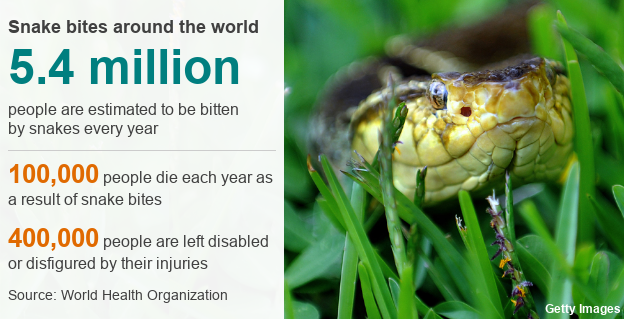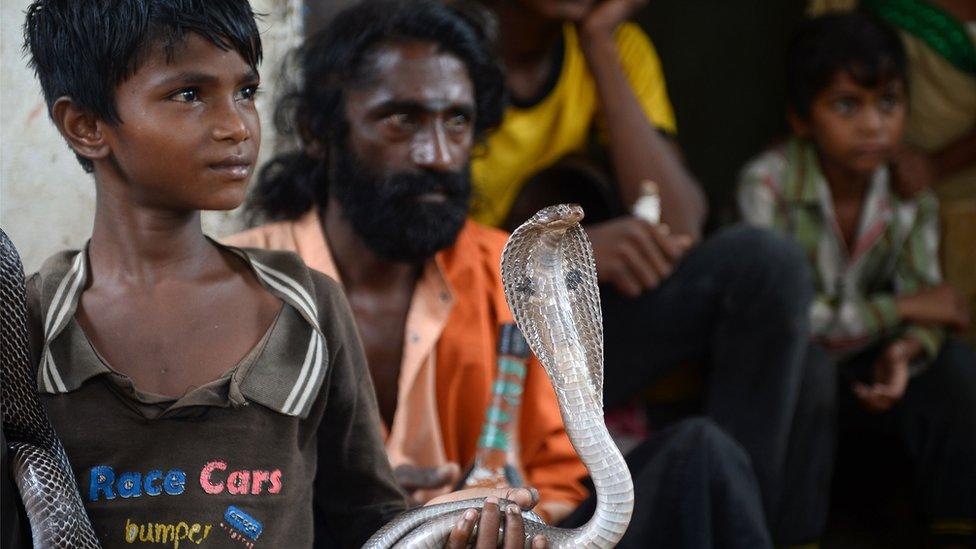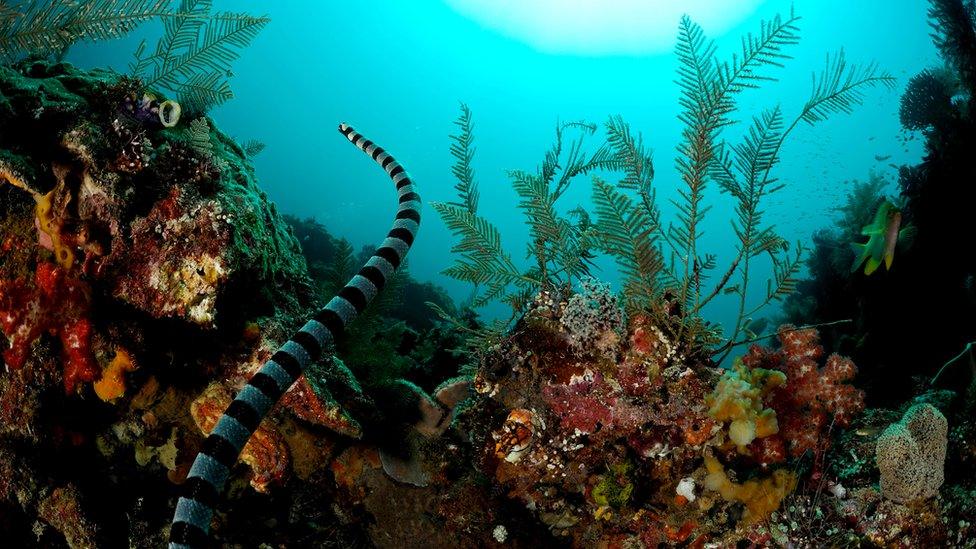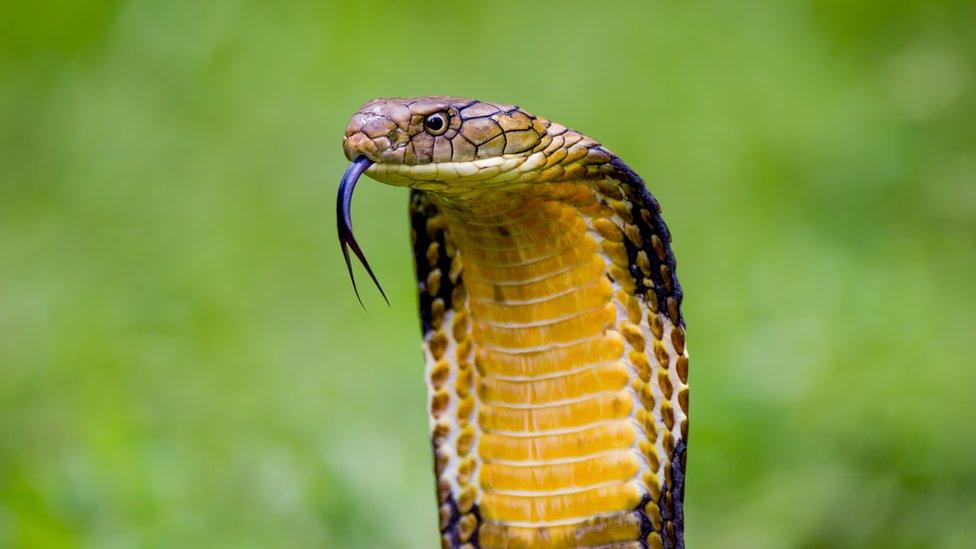Snake bites are now a global health priority, says WHO
- Published

The saw-scaled viper is found from West Africa to South Asia
Snake bites are now a "global health priority" according to a new resolution passed by the World Health Organization (WHO) on Friday.
The WHO says complications linked to attacks make the phenomenon one of the most neglected of tropical diseases.
The world health body will now develop a global plan of action to tackle the issue, which will include providing cheaper antidotes and training.
Between 81,000 and 138,000 people are killed by snake bites each year.
The resolution aims to ensure that countries follow a common strategy in dealing with such attacks.
How big is the problem?
According to the World Health Organization (WHO), around five million snake bites occur each year, although venom is only injected in just over half of cases.
From blindness to amputations, hundreds of thousands of people are left with permanent disability after being attacked by snakes. The WHO describes such cases as among the most neglected tropical diseases.

The majority of snake bites take place in densely populated areas of sub-Saharan Africa, South Asia and South-East Asia, where humans and snakes often come into contact.
Poor, rural populations are at particular risk from snake bites, as they often lack access to antidotes or may turn to traditional treatments in the absence of modern medical facilities.
Many of the worst affected countries do not have their own facilities for producing antivenoms, which must be quickly administered to prevent or halt the damage caused by toxins.
The World Health Assembly's new resolution will ensure that countries follow a common strategy in the prevention, treatment and management of snake attacks.
What happens when a venomous snake bites?
Venomous snakes generally fall into two categories.
Snakes with fixed fangs usually use neurotoxic venom which affects the nervous system and breathing, while other species have folded fangs which are only used when attacking prey or threats. Their toxin usually destroys skin tissue and causes internal bleeding.

Indian cobras, seen here in a village in Uttar Pradesh, are among the species which kill most people each year
Which snakes have the most toxic venom?
It is important to distinguish between the snakes with the most potent venom and those which pose the greatest threat to humans.
The most toxic venom of any land snake is found in Australia's inland taipan.
But while the snake is said to have enough venom in one bite to kill 100 men, there are no recorded human deaths from a bite by the species, thanks to its shy and reclusive nature, its remote location and the widespread availability of antivenom in Australia.
Sea snakes are also highly venomous, but because of their limited contact with humans, bites are relatively rare.
The less-venomous but still highly dangerous black mamba and the coastal taipan (native to Australia) pose a more immediate threat to humans.
Both come from the same family of snakes and their venom is more fast-acting than that of other snakes, meaning that without treatment a bite victim can die in less than half an hour.
The black mamba is in fact brown or olive, but gets its name from the colour of the inside of its mouth. It is found in much of Sub-Saharan Africa and grows to over 10ft (3 metres) in length.
The coastal taipan, meanwhile, is very aggressive compared to its inland cousin.

Sea snakes have some of the most toxic bites, but rarely come into contact with people
Which snakes cause the most deaths?
In terms of numbers of snakebite cases and fatalities, the relatively small saw-scaled viper is one of the most deadly snakes. It is found from West Africa to parts of South Asia and most often bites after dark.
In India, where around half of snake bite deaths worldwide are thought to take place, the saw-scaled viper is one of four species which together account for the highest number of human fatalities.
The other members of the so-called "big four" are:
The common or Indian krait: Although normally docile during the day, it becomes very aggressive at night, and can grow up to 1.75m (5ft 9in) in length
Russell's viper: It is a generally aggressive snake and is widespread across India and South Asia. It feeds on rodents and so is often found near human settlements, both in urban and rural areas
The Indian cobra is found across South Asia. It is widespread in areas without modern medical facilities and attacks after dark, and causes internal bleeding
What should you do if you're bitten by a snake?
The NHS advises the following steps if you or someone else is bitten by a snake:
Remain calm and seek immediate medical attention.
Keep the affected part of the body as still as possible, and remove jewellery or watches
Loosen, but do not remove, clothing
Do not try any of the following steps:
Sucking the venom out of the bite
Cutting the venom out of the bite or making it bleed
Applying anything to the wound, including ice, heat or chemicals
Leaving the person alone
The NHS also advises against putting anything around the limb, such as a tourniquet, as it could make any swelling worse and lead to amputation. The World Health Organization advises the use of the Australian Pressure Immobilisation Bandage (PIB) method only for neurotoxic snake bites, which do not cause swelling.
It is also important not to try to handle or capture a potentially venomous snake. Even dead snakes should be handled with caution, as the nervous system of recently killed specimens may still be active and can deliver a venomous bite.
An earlier version of this story referred to an incident in India in which a child was reported to have died because her breastfeeding mother had been bitten by a snake. The incident was reported by Indian police but experts have cast doubt on the manner of transmission of the venom.
- Published13 September 2015

- Published16 March 2018
